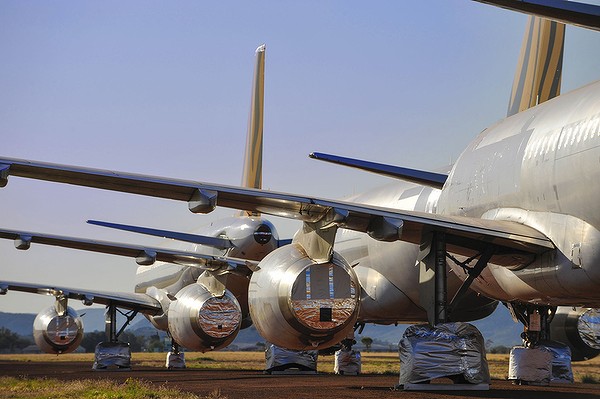It is Australia’s dead centre ??? where our old planes can now go to die.
After a slow start, passenger jets including a Qantas 767 and four Airbus single-aisle planes from Tigerair Singapore have begun to line up at the first large aircraft graveyard outside the US.
The initial stage of the world’s newest “boneyard” at Alice Springs Airport was completed last year but it was not until June this year that it received its first plane ??? an Embraer turboprop.
A number of the latest arrivals, which include a Boeing 737 from Nauru’s Our Airline, have been stripped of some of their livery. The white kangaroo on the tail of the Qantas 767 which arrived a week ago has been painted over in preparation for life after plying routes across Australia.
In the case of the Tigerair planes, engines have been covered as they wait to be pressed back into service once a capacity war in south-east Asia has eased.
Brisbane-based Asia Pacific Aircraft Storage signed an initial 10-year lease with Alice Springs Airport in 2011 to turn the 110-hectare site, which is on the opposite side of the runway to the terminal, into a giant aircraft parking yard.
However, the company did not start construction of the site until the following year.
The challenge for the operator has been to find airlines and aircraft leasing companies willing to overlook the Mojave Desert in California and Arizona’s 840-hectare Pinal Airpark in favour of Alice Springs.
Australia’s dry climate makes many places ideal for aircraft storage. But most places with the right climate lack runways big enough to handle large passenger jets.
Alice Springs, in contrast, can be used by A380s in an emergency.
Asia Pacific Aircraft Storage’s managing director, Tom Vincent, said he expected at least 15 planes at the site by the end of the year.
The arrival of more Qantas 767s would depend on whether the airline was able to find buyers for the old aircraft, which are being replaced by A330s on domestic routes.
Mr Vincent said the maintenance schedule for planes parked at the site was greater than many people believed.
“Every week there is maintenance being undertaken on the aircraft. People like to call it a graveyard or a boneyard but it’s not ??? these aircraft are in active maintenance,” he said.
“They are not simply parked up and left. The aircraft arrives and goes through an induction process, which is preparing the aircraft for storage, and that can take anywhere from four to seven days.”
Qantas plans to retire its fleet of Boeing 767s ??? once the workhorses of its domestic fleet ??? by the end of the year.
The last Qantas 767 passenger service is scheduled for December 27 from Melbourne to Sydney, and many of those twin-aisle aircraft that have been already been retired have ended up at the world’s largest plane parking yard at Victorville, on the edge of the Mojave Desert in California.
Stage one of the multi-million dollar project at Alice Springs covers about 10 hectares and includes two access roads, a maintenance shed, a hard-stand area for up to 25 planes ??? depending on their size ??? and a pad on which parts can be removed or bolted on to aircraft.
Mr Vincent said his company had begun planning for stage two, which would more than double the amount of hard-stand space on which planes could be parked.
His company is backed by private investors, mostly in Brisbane, and eventually plans to extend the parking space to accommodate several hundred aircraft
Source: Sydney Morning Herald (http://www.smh.com.au/business/aviation/outback-plane-graveyard-at-alice-springs-welcomes-first-arrivals-20140926-10m2p1.html)Accessed: 14 Apr. 2015, 11:22am

